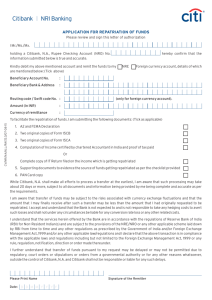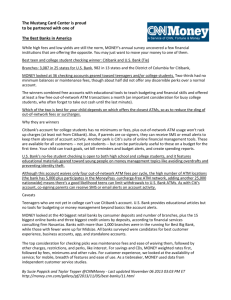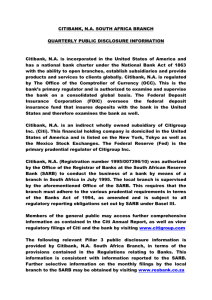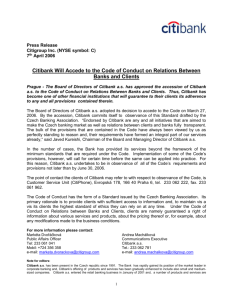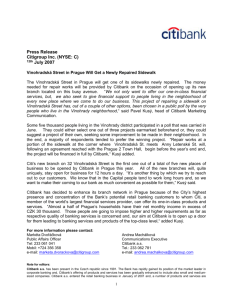Citibank: Launching the Credit Card in Asia Pacific
advertisement
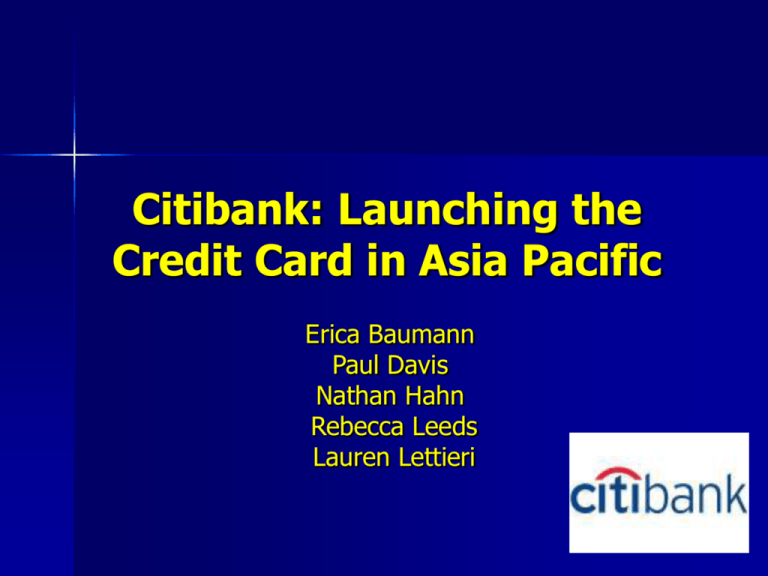
Citibank: Launching the Credit Card in Asia Pacific Erica Baumann Paul Davis Nathan Hahn Rebecca Leeds Lauren Lettieri Overview: Geography of Asia Pacific The Nature Conservancy: http://nature.org/wherewework/asiapacific/ Overview: The Pacific Ocean’s Eleven Hong Kong (1902) Taiwan (1964) Australia (1965) The Philippines (1902) Guam (1969) Singapore (1902) India (1902) Malaysia (1904) Indonesia (1918) Thailand (1967) Korea (1967) Overview: Citibank’s Mission Statement Citibank’s mission in the Asia Pacific region was to be the most profitable provider of a wide array of financial services to an increasingly affluent and middle-income market, and to reach the rapidly growing middle-income households in this region. Overview: Citibank in Asia Pacific 1978-1989 1981: First foreign bank to enter the local trade finance market in Taiwan 1978: Citibank’s Asia Pacific Consumer Bank had established its consumer business in Asia 1983: Citibank enters the credit card market in Hong Kong 1982: Acquired Diners Club in Thailand 1989: Talwar reintroduces the idea of a credit card launch in Asia-Pacific 1986: Begins a period of growth in Thailand and the Philippines 1989: Malaysia and Australia have saturated credit card market Overview: Keys Questions in Asia Pacific Should Citibank launch a credit card in the Asia Pacific region, and in which countries? How should the particular card launches be tailored to each specific country? Business Problems Citibank wondered whether they could adopt a mass-market positioning to acquire enough credit card customers and still maintain its up-market positioning with the current upscale branch banking customers Pricing the card too low would conflict with Citibank’s stated positioning however pricing it too high might mean low customer acceptance Citibank’s management were concerned that consumers’ attitudes and credit card usage patterns differed by country SWOT Analysis: Strengths Undisputed leader of the marketplace Australia: customers see the credit card as an “important shopping tool” Hong Kong: people are used to credit cards- relatively affluent population India: strong economic development in late 80’s Malaysia: large successful business population Singapore: “one of the world’s largest center of traditional trade and services” Thailand: rapidly growing nation (foreign investment) SWOT Analysis: Weaknesses India: consumers do not like to use revolving credit Indonesia: relatively poor country with small upper class; not many qualified for membership Australia/Singapore: saturated market Taiwan: before 1989, laws restricted credit card business Taiwan: culturally not acceptable to owe people money Korea: financial problems in credit card business coupled with stringent local restrictions SWOT Analysis: Opportunities Australia: credit card in conjunction with their banking services Hong Kong: want to target customers outside branch business India: credit card penetration is low Indonesia: upper class growing fast Malaysia: culturally acceptable to revolve credit Philippines: credit card penetration very low Singapore: society prides on innovation and technology and see credit card as convenient Taiwan: most wealthy and best educated country in region Thailand: strong economy = consumer spending SWOT Analysis: Threats Australia: AMEX and Diner’s Club seen as symbol of status Malaysia: many other options to choose from in 1989 (MasterCard and Visa) Singapore: “high-tech mecca” has attracted many multinational corporations Taiwan: restrictive laws prohibited thus industry is in early stages Taiwan: AMEX and Diner’s Club worldwide respected reputation Citibank’s undifferentiated view of one marketplace Most Likely Case Scenario Citibank will enter the market – ''Sometimes, when an economy is under the most stress, you get presented with the biggest opportunities,'' says Citigroup Vice-Chairman William R. Rhodes Cross selling products Market will accept new credit card penetration (except for few countries) Targeting growing upper class market Most Likely Case Scenario Citibank’s credit cards as symbols of status Citibank’s customer base in Asia Pacific region will increase and expand Customers will use their cards for a wide variety of purchases Most Likely Case Scenario Australia: More services will be offered to maximize financial management Hong Kong: Reach customers outside business segment by cross selling India: Increase merchant acceptance Indonesia: Incentives and higher credit limits opportunities Malaysia: Build up credit for future uses Most Likely Case Scenario The Philippines: Market program geared towards gaining acceptance Singapore: Highlight convenience’s of Citibank Taiwan: Promote awareness of the emerging credit card industry Thailand: Two card approach to attract all customer bases Korea: Will not enter due to government regulations Worst Case Scenario Established competition beats Citibank Population too poor to qualify (Indonesia) Government regulation and culture limits acceptance Failure of customers to fulfill payments- large debt Different countries not accepting of consistent multinational strategy Rejection due to national pride and culture (Taiwan) Saturated markets not accepting of another credit card (Singapore) Best Case Scenario Citibank adjusts strategy for specific countries’ needs (including options) OR All countries accept Citibank’s multinational plan Become a penetration leader (Philippines) Utilize Singapore for latest technology Government law changes opens doors (Taiwan) Take advantage of some countries’ growing economy and affluence Make money off of late payments and interest Strategy: Market Entry Greenfield Market Development Direct marketing program – Direct mail – Take-ones – Direct sales force – Bind-ins Strategy: Pricing Low joining fee to induce more customers Higher annual fee to provide a steady recurring revenue Premium pricing for the Citigold card to attract affluent cardholders Strategy: Options $USD as standard currency for all cards Regional Card Center – Lower costs because of economies of scale – Capability to do quick work product launches in Asia Pacific Strategy: Business Segments Non-Resident Indian Business (NRI) – Special offering for Indian customers who did not reside in India International Personal Banking (IPB) – To service the growing group of affluent Asian clients with global financial needs Strategy: Core Products Citi-One Mortgage Power Auto loans Ready Credit Citigold CitiPhone ATMs Go Decisions: Taiwan, India, Indonesia, Malaysia, the Philippines, Singapore and Thailand Reasons – Countries growing along with infrastructure – Rapidly growing upper and middle class Recommendations: – Two card approach- middle class and upscale customers targeted individually – Create status for credit card Go Decisions: Australia and Hong Kong Reasons: – – – – Most developed Westernized nations Strong credit card and financial infrastructure On average, 2 cards per person Wide variety of usages – shopping travel Recommendations: – Two card approach No Go Decision: Korea Reasons: – Regulations do not allow banks to issue cards with revolving credit – Only local currency credit cards allowed – Poor diplomatic relations – Infrastructure and legislation are not conducive to credit card usage Recommendations: – To risky to enter the market Population Breakdown by Income: Asia Pacific Countries % of Population % of Cards # of People # of Cards Cards Per Capita Population # of Cards Above 25000 12500-25000 2% 27% 23,757,500 3,929,250 0.165 4% 35% 42,145,000 5,011,250 0.119 1,145,300,000 14,460,000 6000-12500 5% 31% 58,157,500 4,498,000 0.077 2000-6000 8% 7% 88,000,000 1,021,500 0.012 < 2000 81% 0% 933,240,000 0 0.000 Break Even: Asia Pacific Advertising Budget Overhead Direct Costs $ 2,500,000.00 $ 61,000,000.00 $ 22,500,000.00 TOTAL COSTS $ 86,000,000.00 # of Cards Average Annual Fee Average Joining Fee $ $ Revenue $ 86,292,000.00 900,000 56.13 39.75 Population Breakdown by Income: Malaysia Malaysia % of Population % of Cards # of People # of Cards Cards Per Capita Population # of Credit Cards Above 25000 12500-25000 6000-12500 2000-6000 < 2000 5% 10% 20% 45% 20% 10% 45% 45% 0% 0% 850,000 1,700,000 3,400,000 7,650,000 3,400,000 38,000 171,000 171,000 0 0 0.045 0.101 0.050 0.000 0.000 17,000,000 380,000 Break Even: Malaysia Advertising Budget Overhead Direct Costs $ 2,500,000.00 $ 61,000,000.00 $ 22,500,000.00 TOTAL $ 86,000,000.00 # of Cards Average Annual Fee Average Joining Fee $ $ Revenue $ 88,200,000.00 900,000 64.00 34.00 ANY QUESTIONS?
